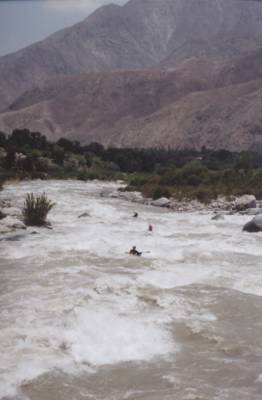
Searching for rare whitewater in the Atacama Desert, Peru.

For anyone about to begin a paddling adventure in land of the Incas, a unique and beautiful place to start is only a couple hours south of Peru's largest and overwhelming city. In February 2003, we decided to begin our South American paddling adventure rather unlikely from Lima, Peru. Flights from North America were cheaper and we heard it was also possible to purchase and register vehicles there. As it turned out, getting our kayaks on the plane was our worst problem and finding a van with little knowledge of Spanish was fairly lucky. However our registration process for our car was a very standard, yet an impatient 2 weeks was spent wondering around Lima. After meeting some new friends, we were surprised to hear that many people from Lima often vacationed in the small town of Lunahuana where camping and rafting trips were most popular. Sure enough, even our Lonely Planet guidebook spoke of quality whitewater found on the Rio Cañete. When our license plate arrived, the fuel tank was filled and we set off in our new home on wheels. Lunahuana and the Rio Cañete would provide a great introduction to the rivers and desert coast of Peru .

Lots of endless grade III - IV whitewater to be found on the Rio Cañete, Peru.

The Rio Cañete(pronounced Can-yeti) flows from the Yauyos Cordillera of central Peru and on down through an arid desolate valley until it empties into the Pacific Ocean about 150 km south of Lima. Raging waters create a lush and temperate oasis along the river. This important climatic zone provides shelter, agriculture and local tourism all within a narrow landscape beneath barren desert mountains. River levels fluctuate in accordance to the wet and dry season of Peru' s high mountains, but the Cañete can be paddled all year long on certain sections. The upper reaches are technical and require low flows during June to September, but the lower Cañete provides excellent rafting and big waves in the high water months of January and February.

Sand meets the ocean in Paracas National Reserve near Ica, Peru.

The logistics for getting to the Cañete are pretty easy if you are using the bus. One must head south from Lima along the Panamerican Highway about 150km until the agricultural town of San Vincente de Cañete. From there you will probably take a smaller bus 30 km to Lunahuana where you can arrange kayak shuttles with the local raft companies, find excellent food, and drink pisco in the desert heat. Check out Kurt Casey's website which provides more information about the fantastic upper Cañete creek run.